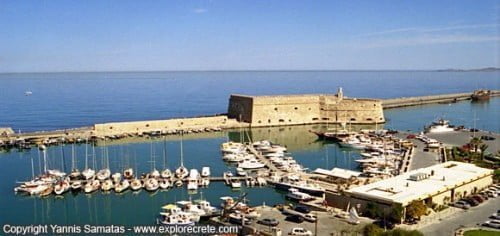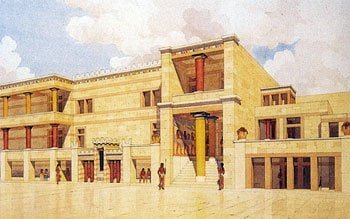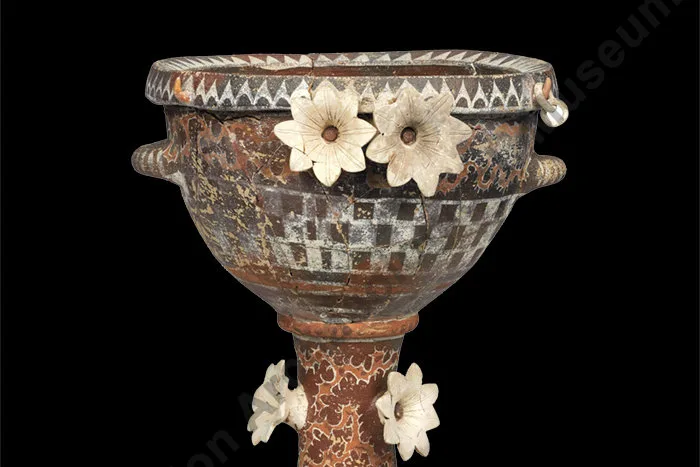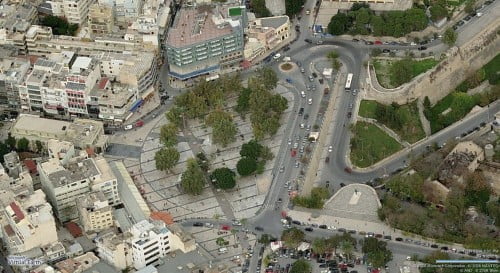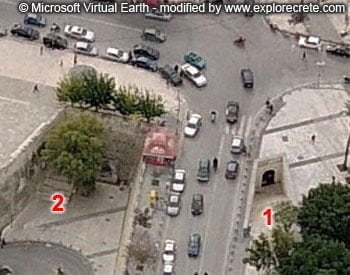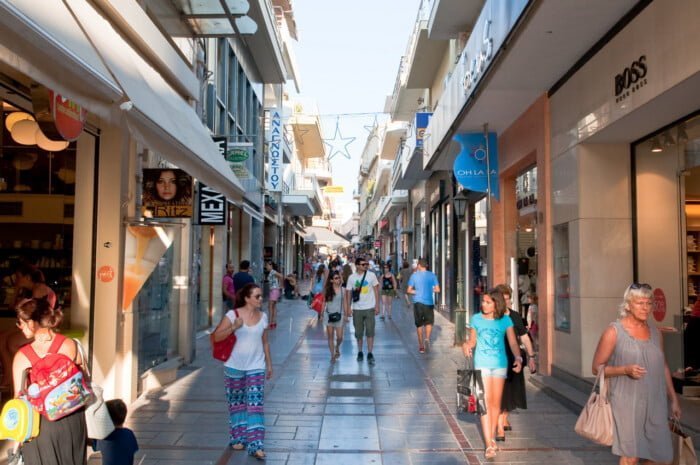Lions Square and Morosini Fountain in Heraklion
The Lions in Heraklion is the square of the Fontana Morosini, the ornate Venetian fountain with four lions with water gushing from their mouths. The Fontana Morosini is in Eleftheriou Venizelou Square in the centre of Heraklion, but the inhabitants of the city never use the official name, usually referring to it as the Lions Square or the Lions for short.
The fountain with the lions is one of the most important monuments the Venetians bestowed on Heraklion. When it was built, it offered a solution to the problem of supplying Heraklion with water, providing 1,000 barrels of water a day.
The Lions Square
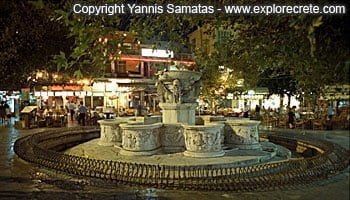
Everyone who has grown up in Heraklion knows that the square of the Morosini Fountain is the Lions Square. However, our municipal authorities decided to make our lives difficult by naming it Eleftheriou Venizelou Square, honouring the Cretan statesman and later Prime Minister of Greece who played a leading role in the struggle for the Union of Crete with Greece.
Eleftheriou Venizelou Square (Lions Square) is one of the busiest parts of Heraklion. It is never quiet, unfolding its various aspects 24 hours a day, 365 days a year. This is where travellers who arrive in Heraklion by ferry at dawn come for a bougatsa cream pie, while they wait for the city to wake up. Later, through the course of the day thousands of locals and tourists will cross the square, stare at the fountain, check out the shops, sit at a café, eat something quick, or visit an exhibition in the Basilica of St Mark.
As night falls, the Lions Square becomes the rendezvous point for groups of young people ready for a night on the town. The same groups will end up at the souvlaki shops and other fast-food joints after midnight, to settle their alcohol-filled stomachs with something on the hoof. Winter and summer, in hot or cold weather, the bustle of the square never stops.
Historical sources tell us that during the period of Arab rule (9th-10th century AD), the square was the largest slave market in the Eastern Mediterranean.
During the Byzantine period (10th-13th century), the Lions Square was the site of the residence of the Byzantine governor of Heraklion.
In Venetian times (13th-17th century), this was where the Palace of the Venetian Duke of Crete (the Palazzo Ducale) stood, where the Duke and his two councillors (Consiglieri) decided the fate of Heraklion and its people. The Ducal Palace was a two-storey building with verandas and vaulted areas on the ground floor which were rented out as shops. It was on the north side of the Lions Square, where the souvlaki shops are today, taking up a whole block.
Opposite the Ducal Palace was the granary, parallel to the Arab-Byzantine wall, which continued from Dedalou Street, embraced the south side of the Lions Square and continued down Chandakos Street to the sea.
The grain warehouse of Heraklion was a long, three-storey building with vaulted areas on the ground floor. The grain market was held on the square in front of the granary, which is why in Venetian times the Lions Square was known as the Piazza delle Biade, or Grain Square. The Piazza delle Biade was the main square of Heraklion and is thought to have been modelled on St Mark’s Square in Venice.
After the Turkish conquest of the island, the Vizier and his retinue established themselves in the Ducal Palace. In 1856 a major earthquake flattened a large part of Heraklion. Among the monuments lost was the Voltone Gate, the main gate connecting the old town to the burgs outside the walls and the villages. The Voltone Gate stood next to the Lions Square, at the Meidani crossroads.
The Morosini Fountain
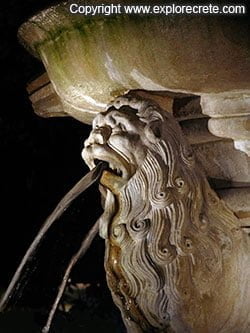
The Fontana Morosini, the famous fountain of the lions, was the work of the Provveditore Generale (Superintendent) Francesco Morosini and the engineers Zorzi Corner, Raffaello Monnani and Francesco Basilicata. The fountain was constructed not for aesthetic purposes but to bring unlimited drinking water to thirsty Heraklion. Heraklion had no springs, and its inhabitants used wells and rainwater cisterns.
Thanks to Morosini, however, water from Archanes on Mt Juktas reached Heraklion along a 15-kilometre-long aqueduct. The work took 14 months to complete and the fountain was inaugurated on 25 April 1628, the feast of St Mark, patron saint of Venice.
The basin of the fountain stands on a circular base and is composed of eight lobes, making it easier for many people to fill their water-jars simultaneously. About five people could dip their jars in the fountain at each lobe.
The lobes of the fountain are decorated with scenes from Greek mythology carved in relief, mainly Tritons, dolphins and nymphs, mythical water beings. At the centre of each lobe were the coats of arms of the Doge, the Duke, the Councillors and Morosini himself.
At the centre of the fountain, on a high octagonal pedestal, sit four proud lions with water flowing from their mouths. The lion is not an animal usually found on fountains, as it is not connected to water, but in this case it was used as the symbol of Venetian power.
At the top of the fountain was a colossal marble statue of Poseidon with his trident, the masterpiece of a local artist. The statue is now lost, and we do not know when it was removed or destroyed.
The Morosini Fountain is the final section of the great Heraklion aqueduct. At its foundations lies the underground reservoir for the water carried along surface and underground aqueducts from Archanes, 15 kilometres away. The ingenious way in which the Venetians made the water flow from the lions’ mouths without a pump from the reservoir is most impressive.
Due to the difference in altitude between Archanes and Heraklion, the water flowed down naturally to the underground reservoir under the fountain. The reservoir was connected to the fountain by a pyramidal structure with a wide base and narrow top (the exit), which increased the water pressure and forced the water up into the fountain, making it gush from the mouths of the four lions.
During the Turkish period, holes were drilled in the lobes of the fountain for the Muslim ritual washing of face, hands and feet before entering the mosque to pray. In 1847, by decision of the Turkish administration, marble columns were added to the fountain, enclosing it. At the top was set a marble plaque with the gilded inscription “Fountain of Abdul Mecit”, in honour of the Sultan.
Today the fountain has been restored to its original condition, by decision of the Municipal Council in 1900.
In recent years, the Municipality of Heraklion had begun an ambitious programme to pave most of the historical centre of the city. In collaboration with the Archaeological Service, the fountain has been restored and water runs from the lions’ mouths once more after years of drought. At the same time, there have been efforts to reveal the Venetian underground ducts which supplied the fountain with water, and make them visible to people crossing the Lions or Eleftheriou Venizelou Square.
Explore Heraklion from the Lions Square
From this spot you have many options of exploring Heraklion:
- Continue along the pedestrian Chandakos Street with its cafés and bars to reach the Heraklion coast avenue, with the Historical Museum of Crete on your right.
- Continue along the pedestrian 25th of August Street to visit the Basilica of Saint Mark, the Loggia, Saint Titus or the Venetian harbour of Heraklion with the fortress of Koules and the shipyards.
- Join us on our tour of Heraklion to the central Meidani crossroads, where we will enter the main market.
© explorecrete.com All Rights Reserved. Reproduction or copying without permission is prohibited.

